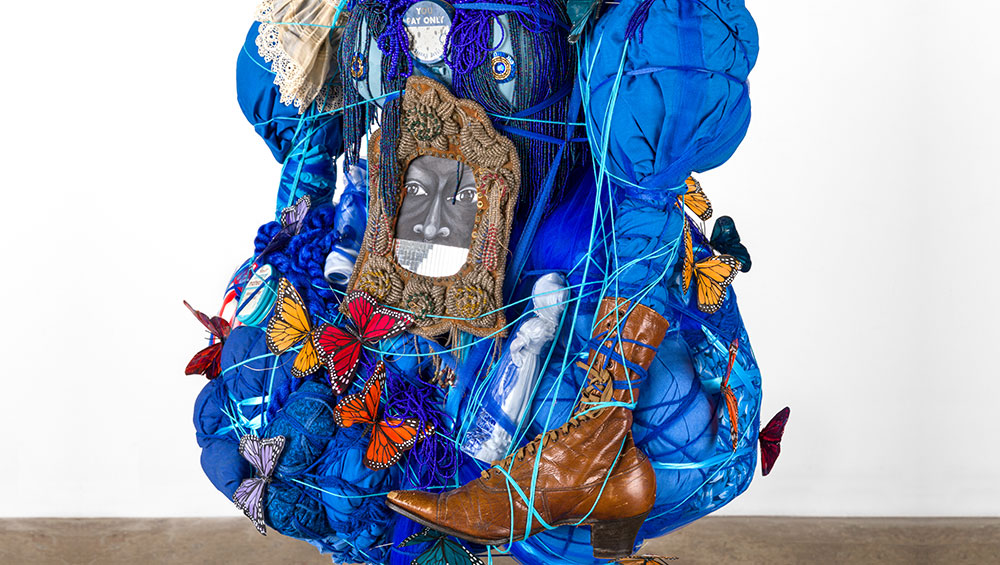
Vanessa German. Hammer Head Rage Machine Agony Machine Baptism, 2019 (detail). Courtesy of the artist and Kasmin Gallery.
Javits Center, New York City
9-14 September 2021
by JILL SPALDING
New, in-person, and as unrecognisable as a friend gone blond overnight, the 27th iteration of the contemporary art-defining Armory Show has been permanently transferred as by magic carpet from two rotting piers to the greatly expanded and easily accessed Javits Center, a luminous urban phoenix risen, as had the Moynihan Train Hall last January, from an unforgiving penumbra. The airy atrium opened by the vast glass-roofed overhaul could itself be a gallery had the fair organisers thought to people it with mega-size sculpture.
Only Covid rendered entry difficult – a five-stop passage for photo ID, vaccination card, bag inspection, body scan and, finally, as with the Freemason’s handshake, the hallowed timed (no re-entry allowed) entry pass. Tellingly, the vibe was more museum than shopping mall. With foreign travel suspended and no starting bell VIP crush, gone was the buzz – that meet and greet “What did you buy? What have you on hold?” that stirs the competitive collector’s blood. In its place, a brilliantly conceived floor plan by Frederick Fisher and Partners, designed more as agora than marketplace, led viewers not gathered at the multiple champagne bars along wide alleys that opened to 157 spacious booths (Covid restrictions kept the additional 50-plus galleries online) that were curated largely for quality. In heartening contrast to the pre-pandemic art fair experience, while the mood was elated – real people! real art! – the material, for the most part, was thoughtful.
Happily, too, for those prone to pandemic fatigue, few works skewed political. Regret not protest infused Misunderstandings, a grouping of ceramics by Jacob Hashimoto at Rhona Hoffman, which references tribal destruction of ancient cultural treasures. Guarded glances and furtive gestures referencing Iran’s history of repression, easing and crackdown, informed the series of paintings depicting a time lapse of student activity – seven sold off the bat – by Moslem Khezri (who still lives in Tehran) that won a booth prize for the Saradipour Art Gallery.
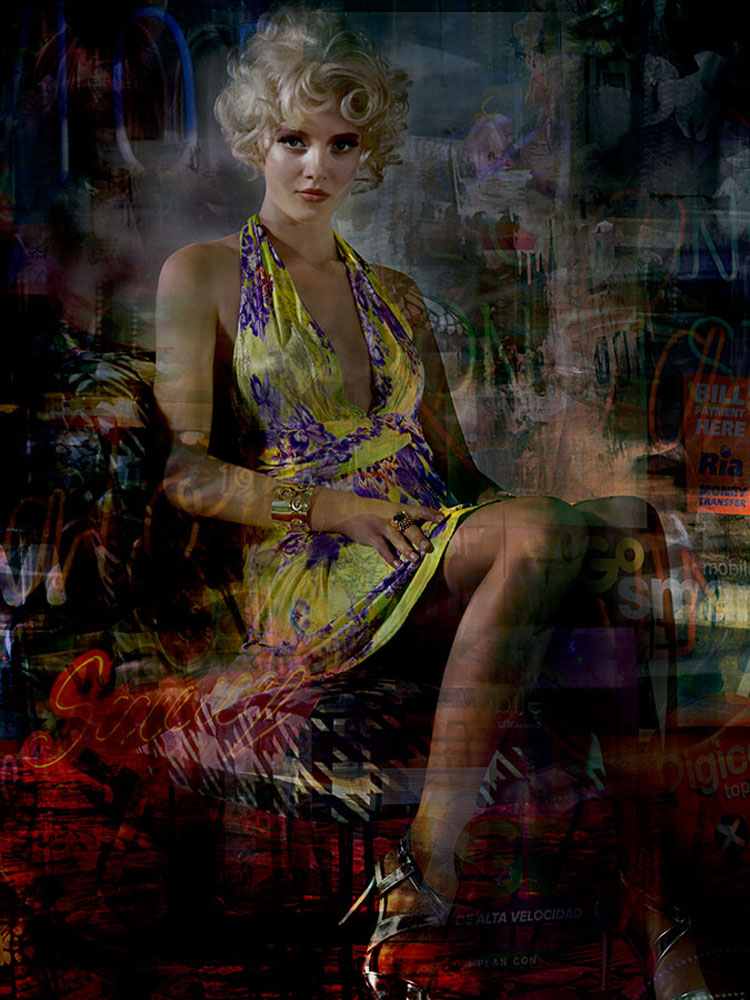
Valérie Belin. Portrait of Gaby, 2020. Archival pigment print, 68 1/8 x 51 1/8 in (172.7 × 129.5 cm). Image courtesy Edwynn Houk Gallery.
Speaking, too, to a gravitas not heretofore associated with art fairs, apart from the occasional gimmickry (floral bouquets hung upside down – please!), there was relatively little eye candy. Even the latter-day boulevardier appeal of Valérie Belin’s 2017 flower girl prints at Edwynn Houk now signals the darker reality of life itself lived on the streets.
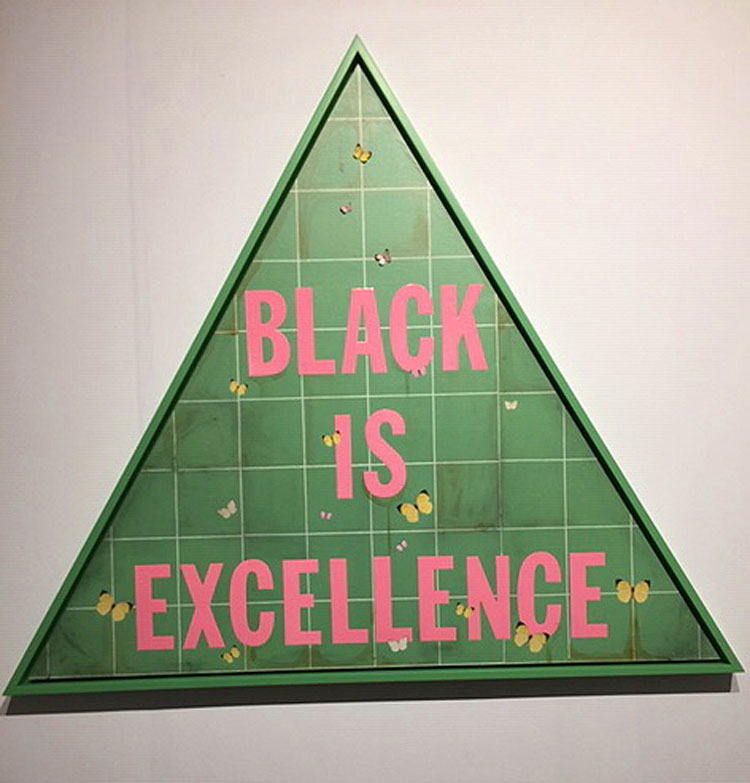
Genevieve Gaignard. Black is Excellence (Just Be), 2021. Mixed media on panel, 41 ¹⁄₂ x 48 x 1 in (105.41 x 121.92 x 2.54 cm). Installation view, The Armory Show 2021. Photo: Jill Spalding.
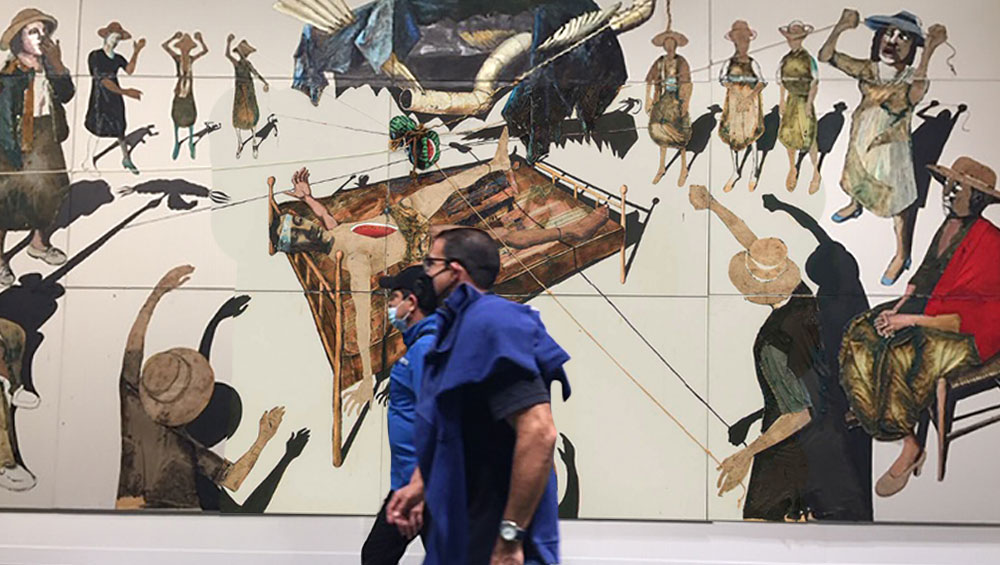
Benny Andrews, Circle, 1973. Oil on 12 linen canvases with painted fabric and mixed media collage, 120 x 288 in. Installation view, The Armory Show 2021. Photo: Jill Spalding.
The overall driver, as expected, was diversity, with black art now so mainstream that it presents more as canon than novelty. Unfurled from a banner work titled Black Is Excellence by Genevieve Gaignard, Benny Andrews’ sprawling work Circle (1973), presented by Michael Rosenfeld at Platform, splayed out a graphic memorial to racial injustice; Sean Kelly showed Hugo McCloud’s Stacked Against the Odds (2021), a poignant take, rendered with single-use plastic, on a third-world living eked out in acrylic and stone by the formidable Sam Moyer (her majestic stone gates have just come down, having anchored the Fifth Avenue and 60th street public space longer than any other commission). Be it due to a resolve to keep prices affordable, or to the irrepressible tsunami of young talent, new names crowded out the so recently crowned pantheon of Njideka Akunyili Crosby, Kerry James Marshall, Henry Taylor, Simone Leigh and Amoako Boafo, drawing, in turn, a new collector base of black viewers.
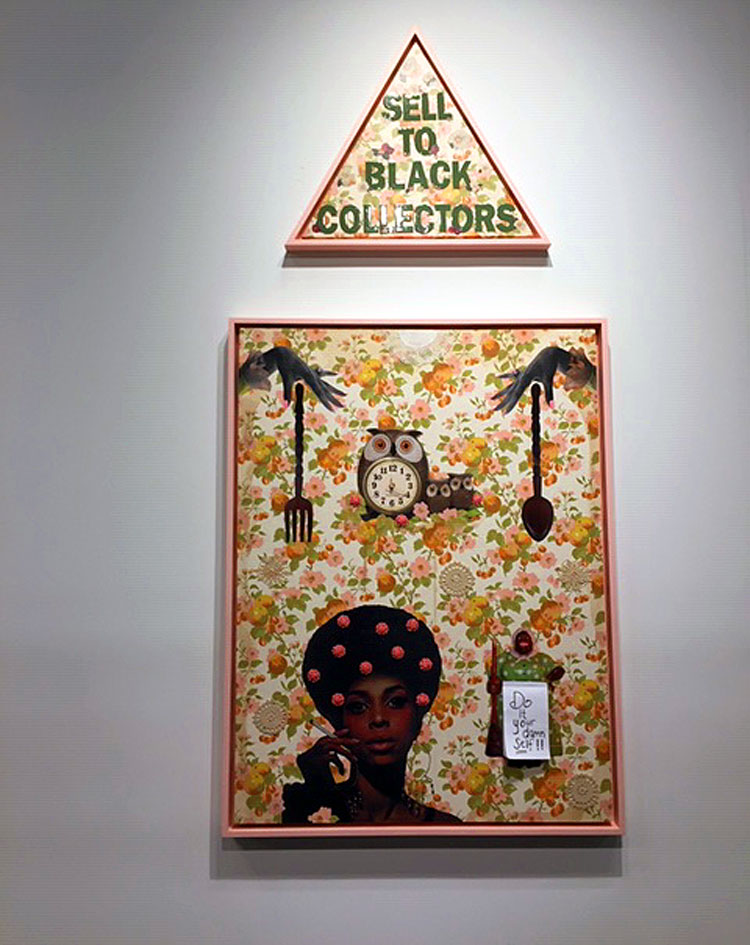
Genevieve Gaignard, Sell to Black Collectors. Installation view, The Armory Show 2021. Photo: Jill Spalding.
Led off by Genevieve Gaignard at Vielmetter with Sell to Black Collectors suspended like traffic signage over her Do It your Damn Self, standouts were a sweat-drenched photo-portrait by Shikeith at Yossi Milo, powerful new work by Didier William that painstakingly carves his voodoo “eyes” signature into canvas and wood metaphors for hope and struggle, viewed here at James Fuentes in the roiling Six Hundred, Twenty Nautical Miles (2021) swim for survival from Port-au-Prince to Miami. New to me, Carla Jay Harris, whose dreamy fables devolving from Ways of Gods (2020-21) at Luis de Jesus are rendered, per caption, with “hand-embellished pigment mounted on Dibond”.
As compelling were sophisticated expressions of Native American art at a level that puts paid to the need to codify it as such. At Sargent’s Daughters, Wendy Red Star’s satirical reworkings of conventional takes on Crow culture; at Garth Greenan, Brad Kahlhamer’s Spirit Animal (2014) and, winning a booth prize for the Marc Strauss gallery, the labour-intensive installation by Marie Watt of the Seneca Nation (see below).
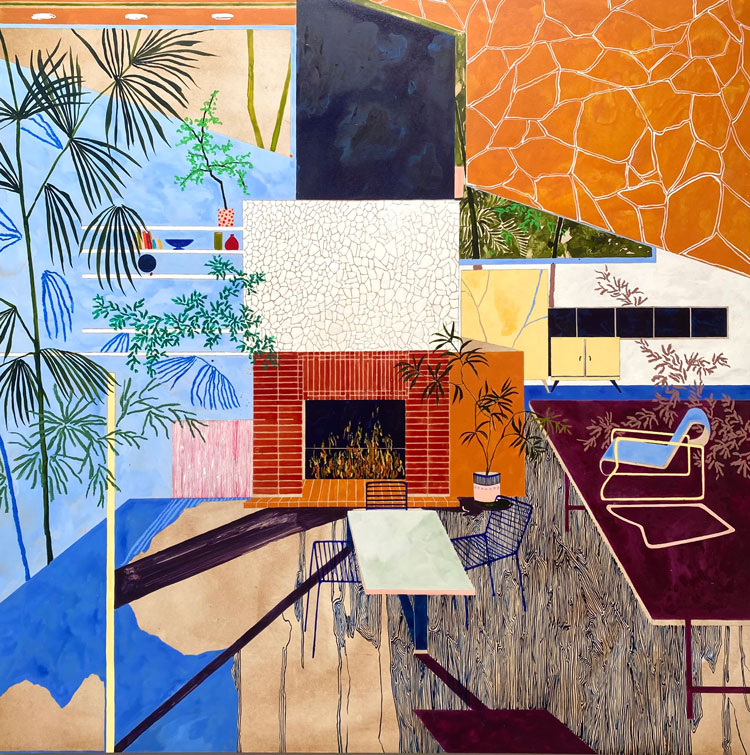
Charlotte Keates. Liquid Wood Grain, 2021. Oil, acrylic and natural inks on board, 100 x 100 cm. Image courtesy Arusha Gallery.
Likewise, the abundance of strong work here by female artists renders mute, if not insulting, the effort to classify them. Ranging from late career (how the art world now dotes on resurrected octogenarians) – Pat Steir going strong at Galerie Thomas Schulte, Michelle Stuart at Galerie Lelong and, not far behind, Lita Albuquerque at Peter Blake – through to emerging – at the Arusha Gallery, the ravishing architectural compositions by Charlotte Keates balanced with pattern and colour.
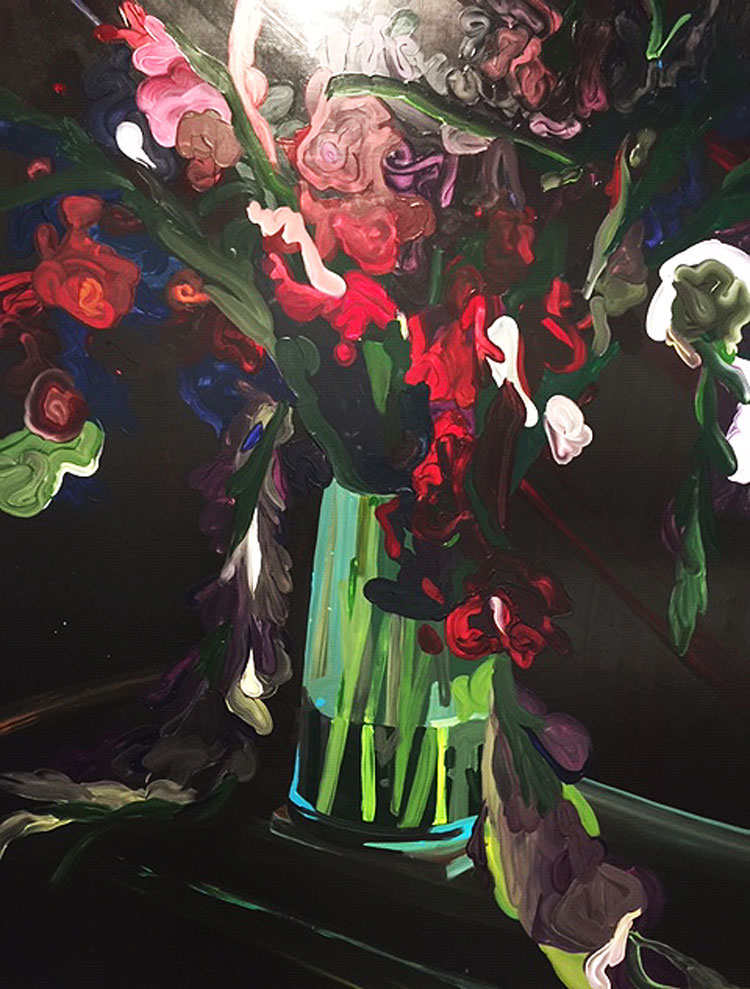
Clare Woods. Fun Wondering, 2021 (detail). Oil on aluminium, 78 7/10 × 59 1/10 in (200 × 150 cm). Installation view, The Armory Show 2021. Photo: Jill Spalding.
Oil on canvas predominated, though several were overlaid with a variety of whatnots. Lovers of straight-out painting rejoiced in Clare Woods’ 2021 oil on aluminium Fun Wondering at Simon Lee, Hernan Bas’s wonderboy fisherman series at Victoria Miro, and a grouping of young painters (notably Pedro Pedro and Rosson Crow) at The Hole.
Sculpture manifested safely with known works by Alice Aycock and Antony Gormley, but the young Ugandan artist Leilah Babirye drew more attention at Stephen Friedman with a totemic portrait crafted of inner tubes from bicycle tyres, ceramic, copper wire and found objects.
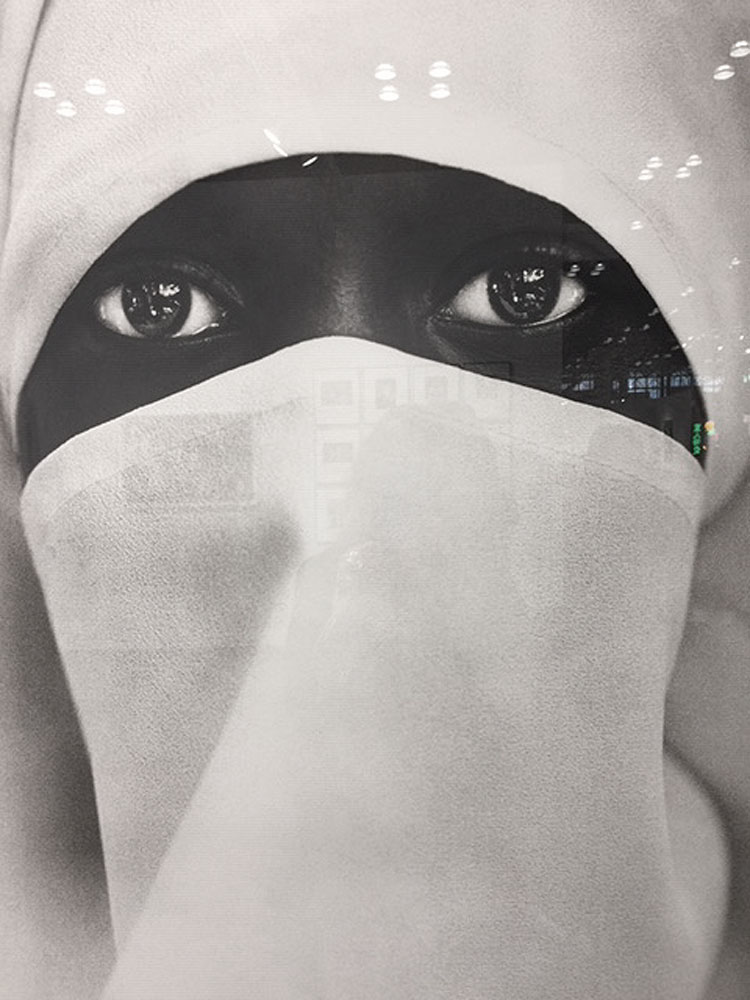
Chester Higgins. A Young Muslim Woman in Brooklyn, 1990. Silver Gelatin Print. Installation view, The Armory Show 2021. Photo: Jill Spalding.
Photography abounded – for the most part (again for safety?) mixed in with other media, though David Zwirner lined a wall with recent work by Wolfgang Tillmans, spiced by a surreal comment on a duck-shoot gone wrong, and Bruce Silverstein spiked his reliable roster of silver-print stars with Chester Higgins’s crowd-drawing A Young Muslim Woman in Brooklyn (1990).

Adam Katseff. River XVIII, 2014. Lacquered pigment ink print. Installation view, The Armory Show 2021. Photo: Jill Spalding.
My return visit was to the Robert Koch Gallery for River XVll (2014/2021) by Adam Katseff, a darkly seductive slash of water that winds eerily through an eternal night.
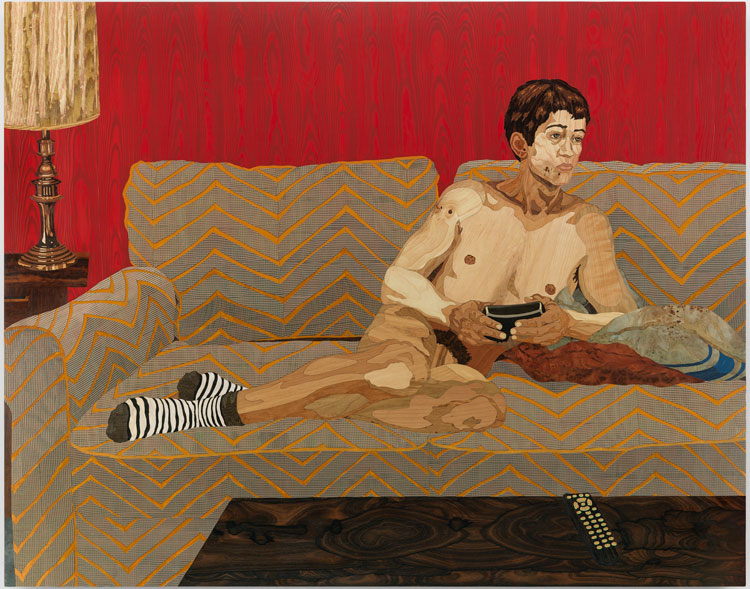
Alison Elizabeth Taylor. Sketch for a Still Life, 2020. Marquetry Hybrid, 50 x 63 in (127 x 160 cm). © Alison Elizabeth Taylor 2021. Image courtesy the artist and James Cohan, New York.
There was no end to bravura accomplishments wrought of traditional and found materials – most markedly, wood, ceramics, rubber tyres and fabric. Drawing viewers was a recent marquetry, Sketch for a Still Life (2020), by the justly lionised Alison Elizabeth Taylor, and Rebecca Manson’s groupings of field flowers in allusive stages of decay (Chemicals? Drought?) Verdure referencing the wilting human condition.
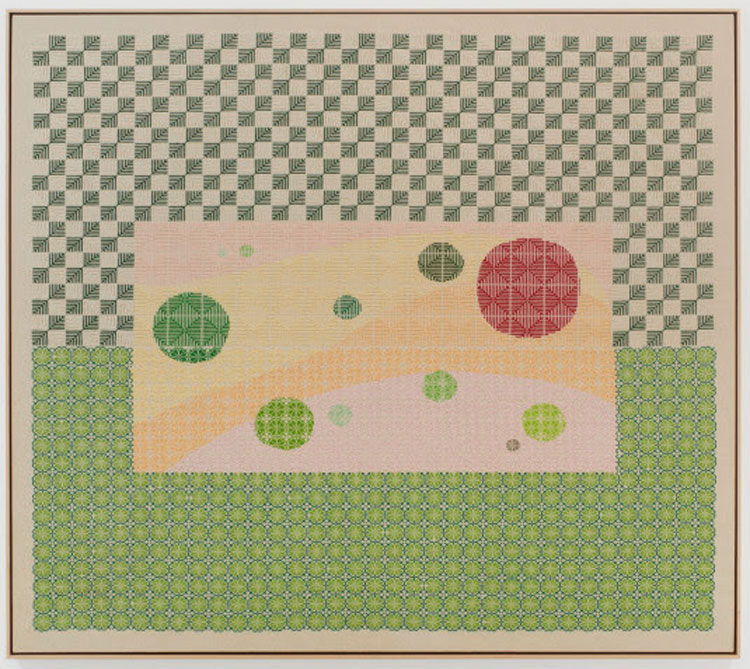
Jordan Nassar. I am half of the universe, 2021. Hand-embroidered cotton on cotton, 49 x 55 1/2 in (124.5 x 141 cm). © Jordan Nassar 2021. Image courtesy the artist and James Cohan, New York.
Most prevalent were thickly textured textile works, the majority so accomplished as to forever elevate them from craft to high art: Jordan Nassar’s hand-embroidered cotton-on-cotton I Am Half of the Universe (2021) at James Cohan; and, at the Ulterior Gallery, George Bolster’s outsized jacquard tapestries – The Double Rainbows of Tatooine (Kepler 16b): Truncated Timelines Inhibit Our Understanding of Who, Where, and Why We Are, 2021 so closely worked it could pass for a modern-day Bierstadt.

George Bolster. A Balance We Need to Strike: Allowing the Next Generation to Live in the Past Perpetuates the Present Stasis, 2021 (detail). Acrylic paint and embroidery on jacquard tapestry, 68 × 53 × 2 in (172.7 × 134.6 × 5.1 cm). Installation view, The Armory Show 2021. Photo: Jill Spalding.
Those who don’t think of textiles as “popping” got an eyeful at the Sapar Gallery with a richly coloured weaving by Faig Ahmed that updates the fabled Emperor’s Carpet at the Metropolitan Museum and, at Victoria Miro, with Grayson Perry’s tour de force Very Large Very Expensive Abstract Painting (2020), a literal urban fabric stitched with suggestive historical commentary – “inheritance”, “museum”, “slavery”, “shareholder”, “rent seeker”, “private police” – like time travel passengers emerging from subway stops.

Grayson Perry. Very Large Very Expensive Abstract Painting, 2020 (detail). Tapestry, 292 x 688 cm (114 15/16 x 270 7/8 in). Installation view, The Armory Show 2021. Photo: Jill Spalding.
I’m still thinking, too, of the luminous installation Skywalker/Skyscraper by Marie Watt that lined up, against a sunrise of beaded and embroidered works sewn by women of her Seneca community, steel-skewered totems she layered from reclaimed blankets to honour the Iroquois “skywalkers” who constructed Manhattan’s skyscrapers – all sold out on opening day.
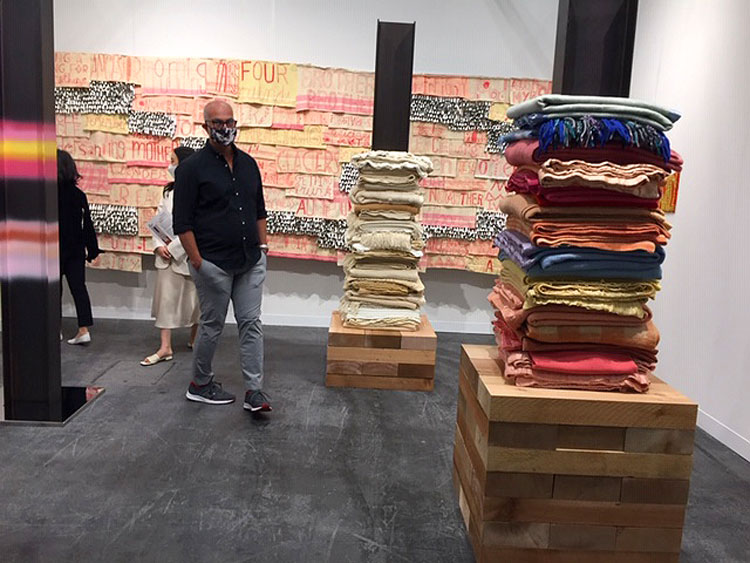
Marie Watt. Skywalker/Skyscraper (Sunrise), 2021. Reclaimed wool blankets, steel I-beam, cedar, 88 x 30 x 30 in (223.52 x 76.2 x 76.2 cm). Installation view, The Armory Show 2021. Photo: Jill Spalding.
A certified trend, voiced by both collectors and dealers, is subtly figurative abstraction. You saw it here at Sean Kelly in Janaina Tschäpe’s Valley 3 (2021), which reads ever so subtly as a biomorphic ecosystem, and at Galerie Thomas Schulte in the is-it-isn’t-it-a-vulva? broad-brush double canvas by Michael Müller, whose right panel is a Where’s Waldo? update of Willem de Kooning’s peekaboo nudes.
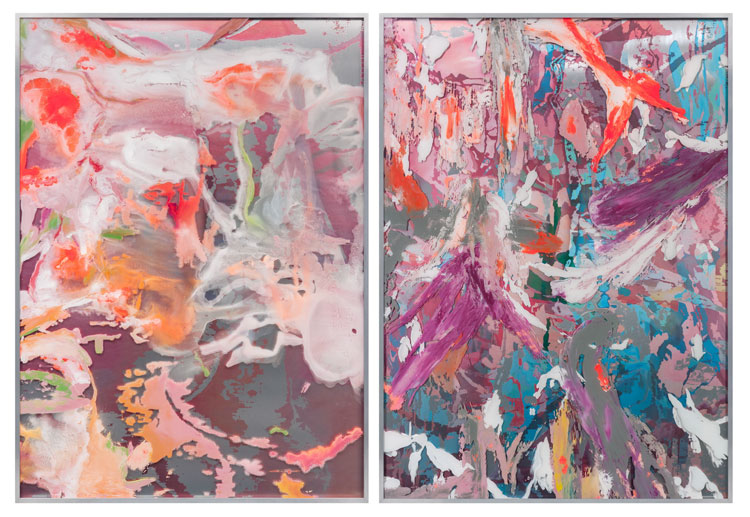
Michael Müller. Fernwirkung, 2021. Two parts work, acrylic, lacquer and gesso on glass and printed aluminium, 202 x 145 x 4.5 cm. Image courtesy Galerie Thomas Schulte.
Social commentary surfed but didn’t sink a handful of text pieces, so many devolving from Mel Bochner (here, too, with Ha, Ha, Ha). Those gathering viewers included Stay Rich (2021) by Birgit Brenner at Galerie Eigen and, at Simon Lee, Jim Shaw’s Pandora’s Box (2020), painted on muslin as a washing machine bubbling out the Obama era’s broken promises.
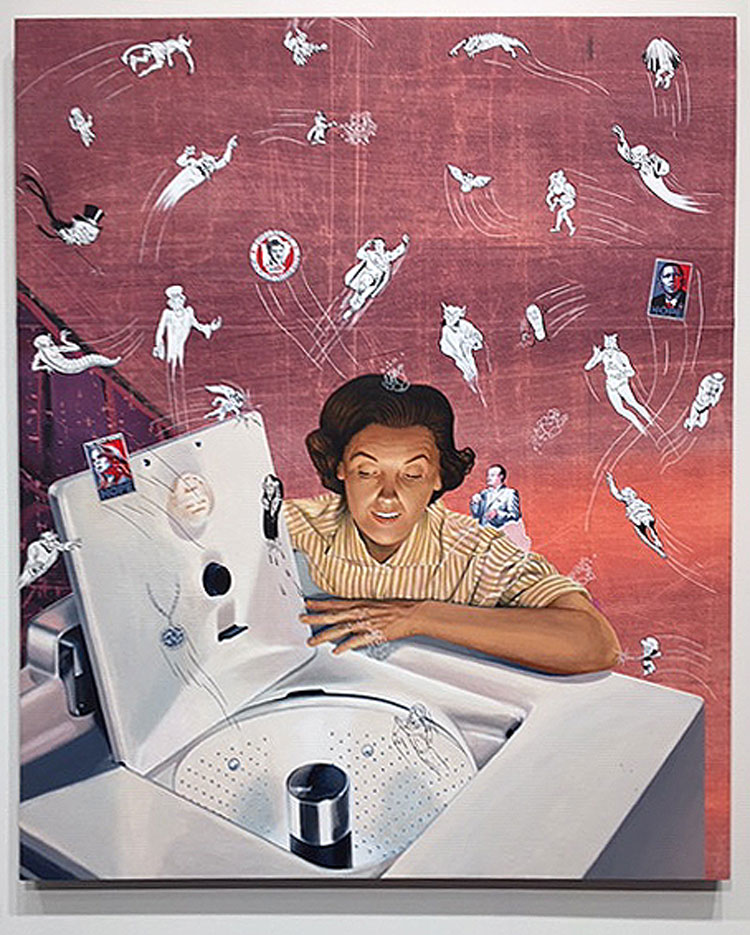
Jim Shaw. Pandora’s Box, 2020. Acrylic on muslin, 119.4 x 101.6 cm (47 x 40 in). Installation view, The Armory Show 2021. Photo: Jill Spalding.
The inevitable crowd pleasers – this is a market after all – manifested at the august Kasmin Gallery with a fancifully pieced cobalt walking man by Vanessa German, and at Fredric Snitzer, with glitter and pearls decking paintings by Vickie Pierre that could have stood on their own.
The old guard was carefully culled for works that looked fresh; at Helwaser, a stunning Tom Wesselmann (reminding why the artist formed one of the triumvirate so aggressively collected by the Nahmad brothers).
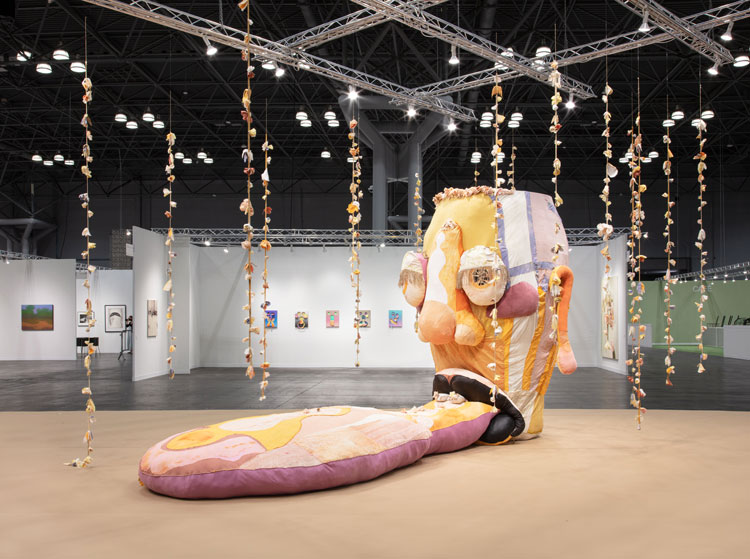
Tau Lewis. Opus (The Ovule), 2020. Courtesy of the artist and Night Gallery, Los Angeles. Photo: Nik Massey.
The only thing dated was shock. Much admired, Tau Lewis must have hoped for a lineup of selfies with Opus (the Ovule) (2020), her colossal in-your-face foam head, staged by Night Gallery at Platform, hung with unreadable cultural signifiers and exuding a tongue representing “the power source of consciousness”, but, perhaps due to far poorer production values than we have come to expect of colossal construction, it remained unloved the four times I returned to it. Caveat: at Edwynn Houk, Sally Mann’s Modest Child #1 (1988) stopped me dead in my tracks for the all-too-fine line it still walks between art and pornography.

Sally Mann. Modest Child #1, 1988. Gelatin silver enlargement print, 24 x 20 in. Installation view, The Armory Show 2021. Photo: Jill Spalding.
There was no dearth of conceptual work, but having zoomed in for 18 months on such subtle expressions, I admit to responding more positively to works that called out to me; worthy as they are, for example, I sped by the much-touted Ana Vitória Mussi’s white lines on black pavement. Eye-grabbing as it was, though, only at the exit door did Art revert to openly to Commerce, with a seductive work of collective graffiti outlined across a vast wall for viewers to crayon in as they liked – but only after committing their email address to a form with the ominously worded promise by Yieldstreet of “a fundamental paradigm shift providing investors access to investments previously available to the top 1%”. Plus ça change!
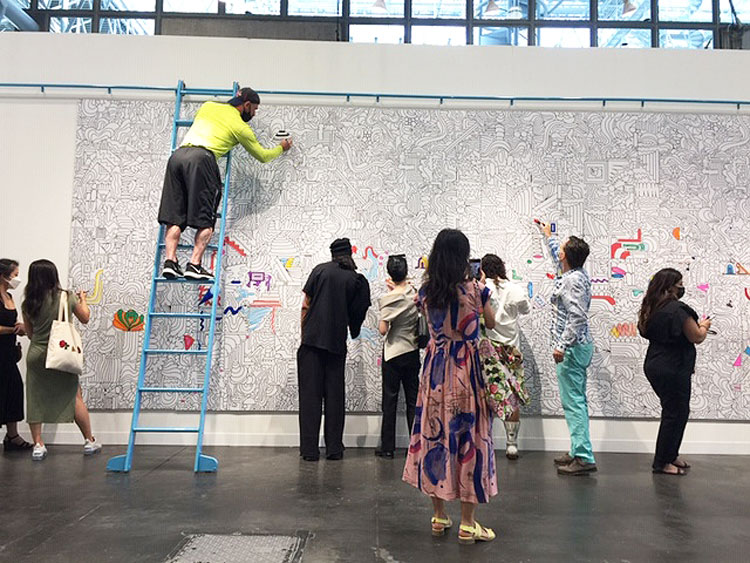
Yieldstreet’s 350-square-foot faux graffiti. Installation view, The Armory Show 2021. Photo: Jill Spalding.